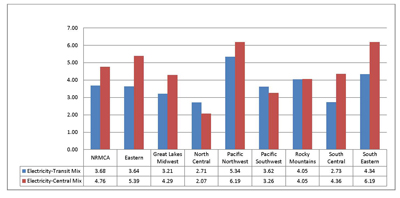The first of two phases in the National Ready Mixed Concrete Association’s development of a standard Environmental Product Declaration (EPD)—aimed at assisting ready mixed producers on projects where customers target certification under the new LEED v4 green building rating system—has produced a survey report and list of participating companies and plants.
The report, posted here, offers a cradle-to-gate Life Cycle Assessment (LCA) for ready mixed concrete and industry average EPD based on data from NRMCA members who have issued plant-specific or company-wide declarations for individual mix designs, or a range of mixes. The LCA and EPD encompass concrete for a variety of applications, strengths, durability classes, slump or spread characteristics, and regions. The final EPD will represent concrete typically used on a variety of projects—from homes to high-rise buildings in different climate zones and markets. LEED v4 requires producers submitting a company-specific EPD on a project to provide data for and be listed, respectively, in industry-wide LCA and EPD.
NRMCA staff will use LCA and survey data in the second phase to establish industry baselines for all environmental impacts, allowing concrete producers to participate further in LEED v4-geared projects by demonstrating they outperform the baseline. A number of baselines will be established at national and regional levels, including those reflecting mix designs with 100 percent portland cement and low- to high-volume supplementary cementitious materials. NRMCA started the LCA and EPD project late last year, targeting a November 2014 completion. Additional information can be obtained from Senior Vice President, Sustainable Development Lionel Lemay, 847/918-7101; [email protected].
NRMCA DETAILS CONCRETE’S CONTRIBUTION TO LEED V4
The National Ready Mixed Concrete Association has published a new entry in the Concrete Sustainability Report series titled, “CSR11: Concrete’s Contribution to LEED v4,” detailing how cast-in-place structures and components augment the U.S. Green Building Council’s new project rating system. Because of its versatility, NRMCA notes, there are many applications where concrete can be used in a building project, from foundation and superstructure to sidewalks and parking lots. That makes concrete unique in that it can contribute to every LEED v4 credit category.
The new NRMCA document provides suggestions for earning LEED v4 points through the use of ready mixed concrete. Examples of how cast-in-place structures and components can be used to influence points in LEED are presented and a table summarizing how concrete contributes to each credit is provided. The eight-page CSR11 is available in packs of 20 for $23 for association members ($27 for non-members). Copies can be ordered through the www.nrmca.org bookstore or by contacting NRMCA’s Jacques Jenkins, 888/846-7622, ext. 1165.
